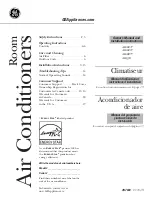
4 Installation
Installation manual
7
RRLQ011~016CA
Outdoor unit for air to water heat pump
4P385895-1A – 2016.03
NOTICE
Make sure to use a recommended bubble test solution
from your wholesaler. Do not use soap water, which may
cause cracking of flare nuts (soap water may contain salt,
which absorbs moisture that will freeze when the piping
gets cold), and/or lead to corrosion of flared joints (soap
water may contain ammonia which causes a corrosive
effect between the brass flare nut and the copper flare).
1
Charge the system with nitrogen gas up to a gauge pressure of
at least 200 kPa (2 bar). It is recommended to pressurize to
3000 kPa (30 bar) in order to detect small leaks.
2
Check for leaks by applying the bubble test solution to all
connections.
3
Discharge all nitrogen gas.
4.3.2
To perform vacuum drying
1
Vacuum the system until the pressure on the manifold indicates
−0.1 MPa (−1 bar).
2
Leave as is for 4-5 minutes and check the pressure:
If the pressure…
Then…
Does not change
There is no moisture in the
system. This procedure is
finished.
Increases
There is moisture in the
system. Go to the next step.
3
Evacuate for at least 2 hours to a pressure on the manifold of
−0.1 MPa (−1 bar).
4
After turning OFF the pump, check the pressure for at least
1 hour.
5
If you do NOT reach the target vacuum or cannot maintain the
vacuum for 1 hour, do the following:
▪ Check for leaks again.
▪ Perform vacuum drying again.
NOTICE
Make sure to open the stop valves after installing the
refrigerant piping and performing vacuum drying. Running
the system with the stop valves closed may break the
compressor.
4.4
Charging refrigerant
4.4.1
To determine the additional refrigerant
amount
If the total liquid
piping length is…
Then…
≤10 m
Do NOT add additional refrigerant.
>10 m
R=(total length (m) of liquid
piping–10 m)×0.054
R=Additional charge (kg)(rounded in units
of 0.1 kg)
INFORMATION
Piping length is the one way length of liquid piping.
4.4.2
To charge refrigerant
WARNING
▪ Only use R410A as refrigerant. Other substances may
cause explosions and accidents.
▪ R410A contains fluorinated greenhouse gases. Its
global warming potential (GWP) value is 2087.5. Do
NOT vent these gases into the atmosphere.
▪ When charging refrigerant, always use protective
gloves and safety glasses.
Prerequisite:
Before charging refrigerant, make sure the refrigerant
piping is connected and checked (leak test and vacuum drying).
1
Connect the refrigerant cylinder to both the service port of the
gas stop valve and the service port of the liquid stop valve.
2
Charge the additional refrigerant amount.
3
Open the stop valves.
4.4.3
To fix the fluorinated greenhouse gases
label
1
Fill in the label as follows:
b
Contains fluorinated greenhouse gases
2
1
1
1
2
2
kg
tCO
2
eq
GWP × kg
1000
=
=
+
kg
=
kg
=
GWP: XXX
RXXX
a
f
c
d
e
a
If a multilingual fluorinated greenhouse gases label is
delivered with the unit (see accessories), peel off the
applicable language and stick it on top of
a
.
b
Factory refrigerant charge: see unit name plate
c
Additional refrigerant amount charged
d
Total refrigerant charge
e
Greenhouse gas emissions
of the total refrigerant charge
expressed as tonnes CO
2
-equivalent
f
GWP = Global warming potential
NOTICE
In Europe, the
greenhouse gas emissions
of the total
refrigerant charge in the system (expressed as tonnes
CO
2
-equivalent) is used to determine the maintenance
intervals. Follow the applicable legislation.
Formula to calculate the greenhouse gas emissions:
GWP value of the refrigerant × Total refrigerant charge [in
kg] / 1000
2
Fix the label on the inside of the outdoor unit near the gas and
liquid stop valves.
4.5
Connecting the electrical wiring
DANGER: RISK OF ELECTROCUTION
WARNING
ALWAYS use multicore cable for power supply cables.
NOTICE
For applications with preferential kWh rate power supply:
The interruption of the outdoor unit power supply may not
be more than 2 hours to guarantee optimised startup
conditions for the compressor.






























